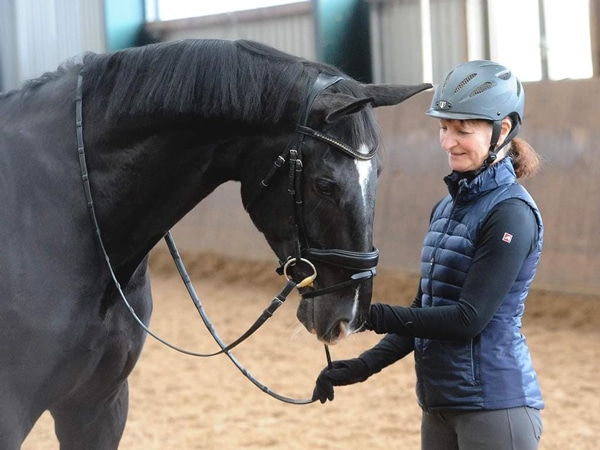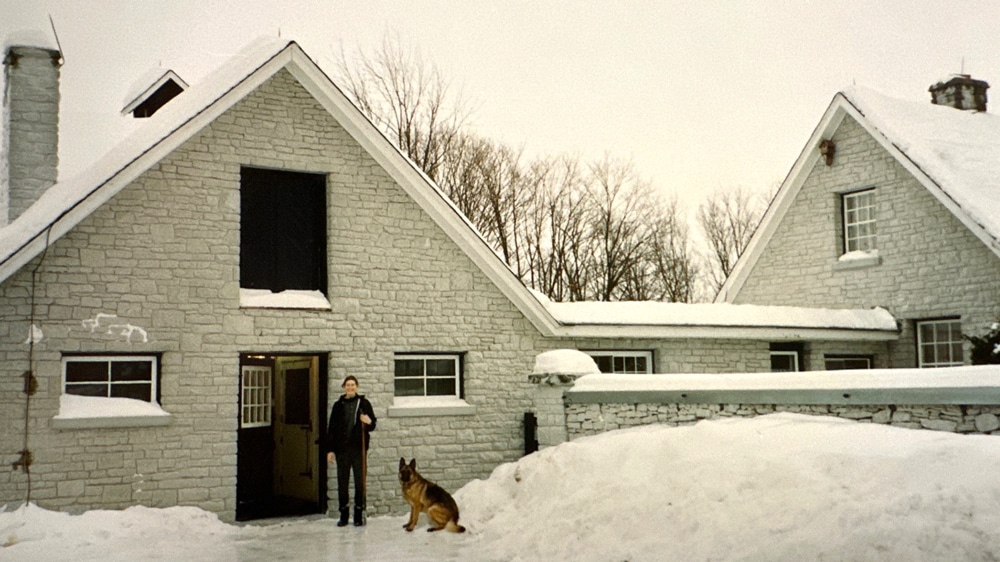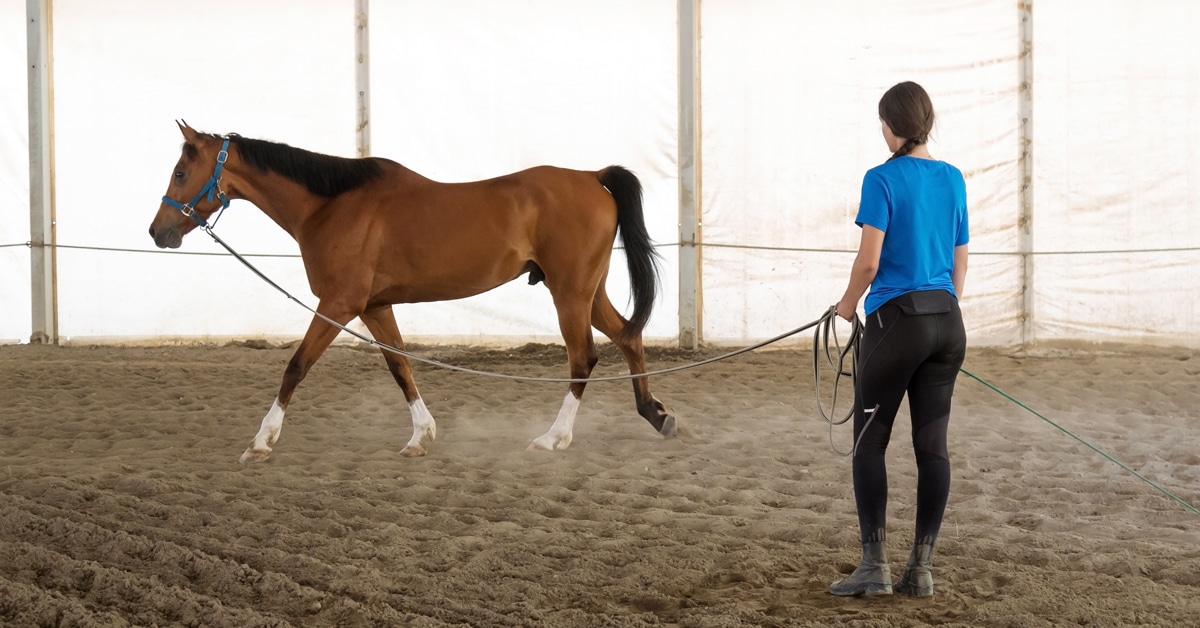If you don’t have the resources to participate recreationally or professionally in the sport, but you love horses and desire a career in the horse industry, becoming a working student is an excellent way to make it happen for yourself. Many high-level competitors, such as Canadian FEI dressage rider Ryan Torkkeli, went from equestrian backwaters to amazing international working student positions that drastically transformed their careers.
The working student program at Franklands Farm, run for the past 35 years by Canadian Olympic dressage medalist Gina Smith, is one of the longest-running and most successful in the country. Smith herself got her start in Europe and Canada working with well-known FEI-level riders as an apprentice and working student.
“I returned to Canada in 1990, after spending eight years in Germany, where I also did a three-year apprenticeship as a working student at Johann Hinnemann’s yard,” says Smith. “Shortly thereafter, I started a working student program. I was a working student in Vancouver for a year and a half with Dietrich von Hopfgarten, so I had some ideas about how to start my own program. I also was a working student for Cindy Ishoy before going to Germany.”
Smith’s working student program has produced an alumni of successful students who have gone on to become industry professionals, EC coaches, and FEI trainers.
“Experience is gained if they are determined to commit to the process it takes to learn the sport and everything that goes with it.”
What Smith Looks for in a Working Student
“Every student is different,” Smith says. She tries to offer students “…something for every interest and try[ing] to mentor those that are willing to stay and work hard at learning all aspects of horsemanship, as well as riding and training. Experience is gained if they are determined to commit to the process it takes to learn the sport and everything that goes with it.”

Gina Smith. (Ingrid Matthiessen Facebook)
Students at Franklands Farm typically work with Smith full-time for an entire year, learning the work of a groom and stable-hand at a top-level competition facility in addition to riding, with room and board on the premises covered as part of the exchange.
“The time commitment is not as easy to get as several years ago,” Smith says. “A lot of students are taking a gap year from school so only want a year…It’s like a university education, a degree doesn’t come in less than a year.”
Shelley MacArthur, Smith’s former working student and current assistant trainer, says a year wasn’t long enough for her. “I had originally committed for the year (at least until September as I had deferred university admission for a year) but as the year drew to a close, I felt like I was just on the cusp of actually putting together all the riding instruction I had received on my own horse as well as other horses. I stayed another year.”
“In those two years, I learned more about taking care of horses, managing a barn and riding than I feel I would have learned taking weekly lessons on my own horse in my lifetime. I got to watch great riders ride and handle lots of different horses daily, and partake in all aspects of horse care. Even the farriers and vets were happy to answer questions and educate us on whatever they were doing while at the farm.”
What to Look for in an Instructor/Employer
If you can arrange a meeting or lesson with your prospective coach before the position begins, this can be a great way to find out if you like her teaching style, facilities, and horses.
“I always invite the students to spend a day or two with us to be sure it is what they are looking for,” Smith says. “It’s the best way to really see how a stable works and what is involved.”
It’s also important to watch people ride and judge for yourself, says MacArthur, who decided she wanted to work with Smith after watching Smith at a show.
“I went to the CDI in Blainville and watched the warm-up and competition rings and decided that, of everyone I saw that day, I wanted to ride like Gina Smith. My instructor at the time was taking some occasional lessons from Gina so I came with her one time and asked about becoming a working student. I came for a trial week in the spring and started in the fall.”
Another helpful way of ensuring you get the most out of the experience is to decide your goals before applying, says Smith. A well-run working student program will function on mutually beneficial exchange. Does the coach seem interested in helping you achieve your goals? Does he or she seem confident about what your role will be?
Clear expectations at the outset will save you a lot of confusion in the long run. Try to make sure you have an agreement beforehand about the hours, time off, and the kind of work you are expected to do, including:
- How often will you be riding, and how often will you get lessons?
- Will you travel to shows, and what will your role be?
- Are you expected to act as the sole groom, or are you sharing the responsibilities with other students?
Above all, make sure to keep the lines of communication open and ask questions if reality deviates from what was promised.
Trish Tweddell, a former working student and Alberta-based coach, trainer, and owner of Eckwood Equestrian Biomechanics, says Smith was instrumental in helping her achieve the early career goal of getting her Pony Club B2.
“I wrote a letter and resume to Gina. I was invited to come to Franklands Farm for an interview, then for a weekend trial; to ride and to learn the day-to-day operations. At the end of the weekend I was offered a position as a working student. I mentioned to Gina that my goal was to complete my Pony Club B2, she agreed to help me.
“In those two years, I learned more about taking care of horses, managing a barn and riding than I feel I would have learned taking weekly lessons on my own horse in my lifetime.”
“[Smith] generously found me a horse (borrowed from Liz Steacie), supplied me with tack, trailered me to cross-country courses to practice. She gave me afternoons off to hack out to Eve Mainwaring’s stables for supplemental jumping lessons. She worked through all the dressage movements with me. Needless to say, I passed my B2.”
You should come away from your initial meeting or discussion feeling informed, prepared, and excited about the opportunity — not like you’re trying to ignore factors that make you apprehensive.
Career Impact
Sometimes, experience working with a well-known trainer at a successful barn can open doors and lead to important contacts within the equestrian community that can eventually help you to develop your own client base.
“When I moved to Alberta, I was welcomed into the equestrian community,” says Tweddell. “Being a Franklands Farm working student alumna meant that I was instilled with Gina’s high standards of horse care and work ethic. I was given so many opportunities to ride and train horses which lead to more opportunities and building relationships within the equestrian community in Alberta. I run my own small farm and equestrian business in Alberta specializing in rider biomechanics.”

Trish Tweddell and friend at Franklands Farm.
Tweddell says working at Franklands Farm changed the course of her career and life. Ultimately, during her time with Smith, Tweddell learned “What it is to be dedicated and disciplined. How to start young horses and present them for breed classes and sale. Being immersed in a world of equestrian excellence with talented horses and riders, I improved in all facets of riding through osmosis…My experience as a working student taught me the power of being part of a supportive community where we all benefit from elevating each other. I am part of a large family of working students, even though I don’t know all of them, I know that we have shared similar experiences from our time at Franklands Farm. I have made lifelong friendships with other working students both nationally and internationally. When I went back to university in 2003, I lived with Gina’s mother in Saskatoon.”
MacArthur agrees that her time at Franklands Farm was vital in shaping her career. “I feel that had I not taken that jump and done the year-that-became-two-years as a working student at Franklands Farm with Gina Smith, I would still be taking my weekly lesson and dreaming of being good enough to be a professional.”
***
If you are interested in becoming a working student in Canada, try sites such as equinejobtrack.com, yardandgroom.com, Facebook groups including Equine Jobs and Working Student Positions (or search Horse Jobs in your province), or contact stables near you to ask if they have programs available.

